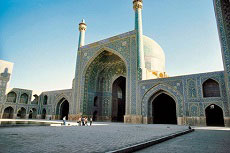Literally meaning “The Image of the Universe”, Naghsh-e Jahan Square in Isfahan is one of the biggest city squares in the world. Constructed in the center of Isfahan between 1598 and 1629, this square is the centerpiece of Isfahan’s tourist attractions. This important historic square is 160 meters wide and 560 meters long and has been enlisted by UNESCO as a world heritage site. To say nothing of the beautiful square itself, there are two magnificent mosques around the square that are considered the masterpieces of the time’s architecture fostered by the powerful rulers i.e. the Safavid Dynasty. These mosques are called Shah and Sheikh Lotf Allah Mosques. The former is located at the southern side of the square and latter at the eastern side. However, as the rectangular shape of Naghsh-e Jahan Square suggests, the grandeur of the square is not just because of the two mosques; there is Ali Qapu Palace at the western side and also Qeysarieh Portal at the northern side of the square. The latter leads the visitors to Isfahan’s Grand Bazaar.

When Shah Abbas the Great moved the Persian Empire’s capital from the north-western city of Qazvin to the central city of Isfahan with the purpose of keeping the capital safe from the Ottomans’ invasions, he decided to make the city a perfect epitome of his empire’s advanced art and architecture. Therefore he put Shaikh Baha’i, one of the greatest scholars in history, in charge of the city’s main features’ design, namely that of Charbagh Avenue and of course Naghesh-e Janan Square.

Naghsh-e Jahan Square’s design is truly brilliant. It’s brilliant not only in terms of its architecture, but also in terms of the ideology that underlies this amazing sight. Naghsh-e Jahan Square represents the Empire’s three elements of power at the time. The first of these elements was religion that was represented by Shah Mosque. The second element was economy, represented by Isfahan’s Grand Bazaar, and the third element was the Shah himself who was represented by Ali Qapu Palace in which he lived. If you take these elements into account and know that the literal meaning of Naghsh-e Jahan Square is “The Image of the World”, you will get a clear idea of how Abbas The Great became one of the most powerful kings in the Persian history.
0 Comment(s)
|
Comments and Reviews |
|
|